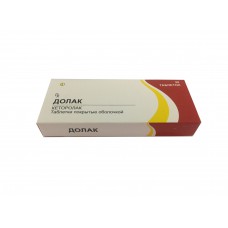Expiration date: 12/2026
The composition and form of issue:
1 tablet coated liner contains trometamina Ketorolac 10 mg, in a contour bezgyachakova packing 10 PCs., in box 2 packaging.
1 ml solution for injection 30 mg in 1 ml ampoules in a box 10 ampoules.
Pharmacological action:
Inhibits cyclooxygenase (mostly in peripheral tissues), inhibits the synthesis of PG — modulators of pain sensitivity, thermoregulation and inflammation. Analgesic effect develops within 1/2 hour, reaches a maximum at 1-2 hours and lasts for 4-6 h. Inhibits platelet aggregation, reduces thromboxane concentrations and prolongs bleeding time.
Pharmacokinetics:
After the/m injection in a dose of 30 mg C max in plasma is reached in 50 min and is 2, 2-3, 0 ág/ml After in bolus injection in a dose of 10 mg Cmax (2, 4 µg/ml) is reached after an average of 5, 4 min After in/with the introduction of an initial loading dose of 30 mg within 15 h, the subsequent continuous infusion at 5 mg/h provides the same concentration of the drug in the blood plasma, as the/m in a dose of 30 mg every 6 h If ingestion is well absorbed after ingestion on an empty stomach in the dose of 10 mg Cmax in the blood plasma (0, 7-1, 1 µg/ml) is achieved after 40 min. Fat-rich food reduces the magnitude of the Cmax and increases the time to reach for 1 h Almost completely (99%) associated with blood plasma proteins (hypoalbuminemia increases the free fraction). The volume of distribution after a single dose is 0, 15 l/kg. poor passes through GEB, crosses the placenta (10%), in the small quantities found in breast milk. T1/2 is 5, 3 hours (in patients older than 65 years or with impaired renal function increases to 1, 5-2 times). It is metabolized in the liver to form conjugated and hydroxylated forms (the main metabolite — hydroxyketones, pharmacologically inactive ). Is eliminated through the kidneys (up to 92% of the administered dose, of which, 40% is in the form of metabolites, and 60% in an unmodified form), about 6% is excreted in faeces.
Indications:
Pain syndrome moderate and strong intensity (short-lived relief, mainly in the postoperative period).
Contraindications:
Hypersensitivity including to other NSAIDs, gastric ulcer and duodenal ulcer in the acute stage, a history of ulcers, perforation or gastrointestinal bleeding, moderate and severe renal insufficiency, the risk of development of hypovolemia or dehydration, hemorrhagic stroke, status with high risk of bleeding or incomplete hemostasis, preoperative period and during surgery (because of the high risk of bleeding) concurrent use of other NSAIDs, including aspirin and pentoxifylline pregnancy, delivery period, breast-feeding, age up to 16 years.
Application of pregnancy and breastfeeding:
Contraindicated. At the time of treatment should stop breastfeeding.
Side effect:
From the nervous system and sensory organs: headache, dizziness, nervousness, tremor, impaired ability to focus attention, asthenia, depression, hallucinations, paresthesia, seizures, violation of taste and vision.
From the cardiovascular system and blood (hematopoiesis, hemostasis): reducing or increasing blood pressure, heartbeat, anemia, eosinophilia, thrombocytopenia, leukopenia.
Respiratory system: dyspnoea, cough, bronchospasm, bronchial asthma, pulmonary edema.
On the part of the digestive tract: dry mouth, stomatitis, nausea, vomiting, feeling of fullness of stomach, flatulence, constipation or diarrhea, dyspepsia, gastritis, peptic ulcer, rectal bleeding, melena.
With the genitourinary system: hematuria, glomerulonephritis, nephrotoxic syndrome, acute renal failure, urinary retention, polyuria, frequent urination.
With the skin: pallor, itching, rash (including hemorrhagic), pain at the injection site.
Allergic reactions: anaphylaxis, anaphylactoid reaction, laryngeal edema, tongue swelling.
Other: violation of the liver.
Drug interaction:
Acetylsalicylic acid and other NSAIDs mutually increase the risk of developing severe side effects. Pentoxifylline and substances that affect hemostasis (warfarin, heparin, dextrans) increases the likelihood of bleeding. Probenecid reduces plasma Cl and volume of distribution, increases concentration in plasma, and T 1/2. Reduces diuretic effect of furosemide. Concurrent use with ACE inhibitors may increase the risk of renal dysfunction.
Method of application and doses:
Inside, in/in (struino for at least 15 seconds), in/m (deep in the muscle, slow). Dose picked individually, taking into account the severity of pain.
Single dose in the/m introduction patients up to 65 years — 10-30 mg, every 4 to 6 hours for Patients older than 65 years or with impaired renal function 10-15 mg every 4-6 h in patients up to 65 years 10-30 mg, every 6 hours (with continuous infusion — initial dose of 30 mg, then at 5 mg/h) patients older than 65 years or with impaired renal function — on 10-15 mg every 6 hours jet. Duration of use not more than 5 days.
Inside of 10 mg up to 4 times a day. The highest daily dose — 40 mg. the duration of the course not more than 7 days.
When switching from parenteral administration of the drug on its intake the total daily dose of both medicinal forms in day of transfer should not exceed 90 mg for patients till 65 years and 60 mg for patients older than 65 years or with impaired renal function (the dose in tablets is not to exceed 30 mg).
Overdose:
Symptoms: pain in the abdomen, nausea, vomiting, the appearance of peptic gastric ulcers or erosive gastritis, violation of function of kidneys, gastrointestinal tract, hyperventilation.
Treatment: gastric lavage, introduction of adsorbents (activated carbon), symptomatic therapy.
Precautionary measures:
Before the introduction of Dolac is necessary to eliminate hypovolemia, hypoproteinemia, and to restore fluid and electrolyte balance.
When combined with opioid analgesics dose of the latter should be significantly reduced.
When using the Dolac is recommended to avoid the performance of work requiring increased attention and speed of reaction.
The drug should not be used to treat chronic pain.
Special instruction:
A solution of Dolac for injection is incompatible in the same syringe with prometazinom, hidroxizina (precipitate) is compatible with physiological saline, 5% glucose solution, ringer solution , a solution of "Plasmalite", as well as with infusion solutions, containing aminophylline, lidocaine hydrochloride, dopamine hydrochloride, human insulin short-acting and heparin sodium salt.
Dolac
(Ketorolac)
- Brand: Cadila



